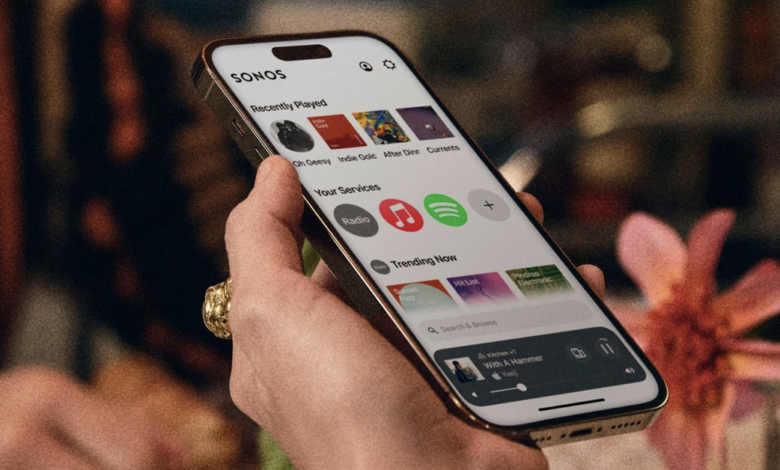Sonos customers complain about missing features in redesigned app in community AMA

A week after introducing a redesigned, sleeker app that omitted many core features, Sonos held an Ask Me Anything event on its forums today. The purpose was partly to make it clear that customer frustrations are being heard. But as has been the case since last week, the feedback skewed overwhelmingly negative. This company’s community remains pretty damn angry over losing software capabilities like local music search, sleep timers, and more with no warning.
Many participants asked Sonos why it released an app that was nowhere near on par with the previous version in terms of functionality — even after, as The Verge has learned, private beta testers raised concerns with the state that the software was in before launch. And they were often less than satisfied with the answers given by Sonos’ product team.
Let’s start with the big “why now” question. Tucker Severson, director of product management, attempted to address that with the following response:
An app is never finished!
It’s probably a good idea to give you some background. This is a new app – we started from an empty project file. As the project progressed, we stopped investing our time in the old app code. Over time we “cross-faded” our engineering attention into the new app. We need to make the new app be the app going forward so we stop splitting our attention.
We decided that now is the moment to bring you the new app. This is the beginning, and we will be continually iterating going forward. As I said – an app is never finished.
Granted, that doesn’t actually explain what was so pressing that the app needed to ship in early May — several weeks ahead of a rumored June release for the long-awaited Sonos Ace headphones, which will be reliant on the new app.
As for the motivation behind the big visual overhaul, senior director of user experience Kate Wojogbe said that “the refreshed UI design is rooted in the needs that we’ve been hearing from our listeners for years. We heard from users that the information architecture of the S2 app felt like work, particularly in navigating between multiple tabs to get core jobs done.”
Sonos believes the new app’s customizable home feed does a superior job putting the most useful content and controls “immediately within thumb’s reach.” And the software stack has been modernized to take advantage of newer APIs, hopefully ensuring smoother system performance long into the future.
I don’t want to pile on here. As I’ve said from the start, depending on how you’ve always used the Sonos app, this new version indeed feels better to some people! But the poorly managed rollout is proving to be Sonos’ biggest unforced error yet. The S1 to S2 software transition was overblown by some; only the company’s very oldest products were left behind on the legacy platform. They still work! And the S1 app remains available to keep it that way.
But this situation has seriously shaken trust in the brand for those who regularly used now-missing features like local music search, sleep timers, and more. According to Sonos’ recent estimates, some of those capabilities won’t be coming back until June. It’s perfectly fair to question why there was never an open beta for this reworked Sonos app or a transition phase between old and new to prevent customers from suddenly losing functionality. The company’s emails advertising the new app didn’t mention any of these shortcomings.
The ability to create alarms only just returned with a system update today. But the explanation for that bug is really emblematic of this whole situation and suggests that the software wasn’t ready for prime time. Here’s how senior director of software engineering Diane Roberts laid it out:
On the morning of the app launch, we discovered a data corruption error around the new Alarms APIs. The corruption could cause alarms to go off in the wrong room at the wrong volume with the wrong content! In order to save your alarms, we made the difficult decision to remotely disable the alarm settings feature and then completely lock it out. It allowed us to make sure your alarms stayed as they were – but at the steep cost of taking away your ability to change them yourself.
The team rallied to make sure we could turn this feature back on safely – and today we are so delighted to say that we have re-enabled alarm settings. To get this feature, you must do a full system update.
But that’s not how we expect to introduce features every time. We have built the new app to be able to update independently of the speaker firmware. As we go forward, you can expect us to bring out new features with smaller, less intrusive, updates.
iOS customers have no viable way of downgrading to the previous app experience. And while it’s technically possible to do so on Android, Sonos is now advising against it.
“Rolling back to the previous version of the Sonos app is likely to cause issues,” Severson wrote. “As Sonos continues to advance forward with new updates to the firmware, the old apps will fall out of compatibility quickly. Our priority is to release improvements to the Sonos app rapidly to address your needs.”
Any user experience makeover inevitably brings many questions, and shipping with a lengthy list of missing features was always going to cause consternation among longtime customers. So it’s completely understandable why many of Sonos’ loyal fans are annoyed by such a drastic shift and confused by the seeming urgency. What was the rush here?
But if you’re looking for a reason to have confidence that things will get better — and hopefully soon — remember that these people are all frequent users of the products themselves.
Here’s Diane Roberts again:
We have all been deeply invested in this project for a long time. We are all Sonos owners. Many people on the team had Sonos in their homes before they joined the team. We all use the experience every day.
Any time we change an experience or delay a feature, we know that some people will have negative sentiments. We also saw in our usability testing that people appreciated the new user interface, adaptability, and faster time to music.
We have been reading your posts and seeing your feedback.
Once the release went live, the mood could be described as “energized.” The activity on the team is high as people share what they’ve built for the next releases. We are excited that we can bring these continuous regular updates. It’s easier and faster now for us to share what we’ve built with you. That started with today’s release and will continue on May 21st with releases to follow.
Let’s hope so. If it’s any consolation, there are still improvements and new features coming amidst all this change: Sonos just today added support for lossless Apple Music tracks, giving customers another way of getting the most fidelity from its speakers. And the company is keenly aware that there’s more work to be done before it can put this ordeal behind it.
“What we learned this past week is that we should have communicated more openly with you about changes that may impact you,” Severson wrote. “Over the coming weeks and months, we seek to fix the issues that you have surfaced and earn back your trust.”



